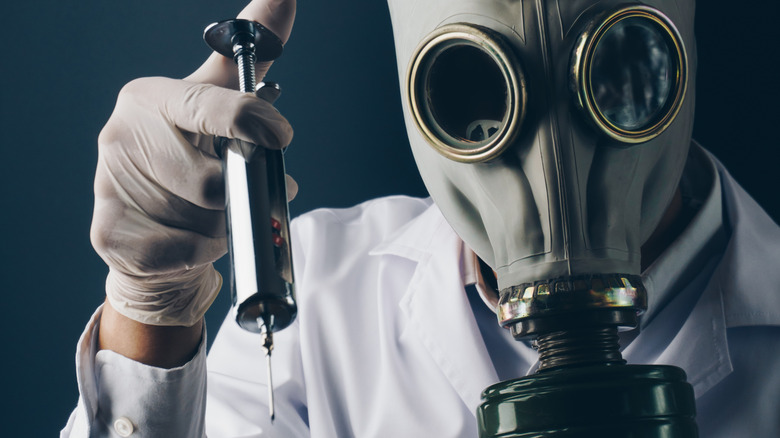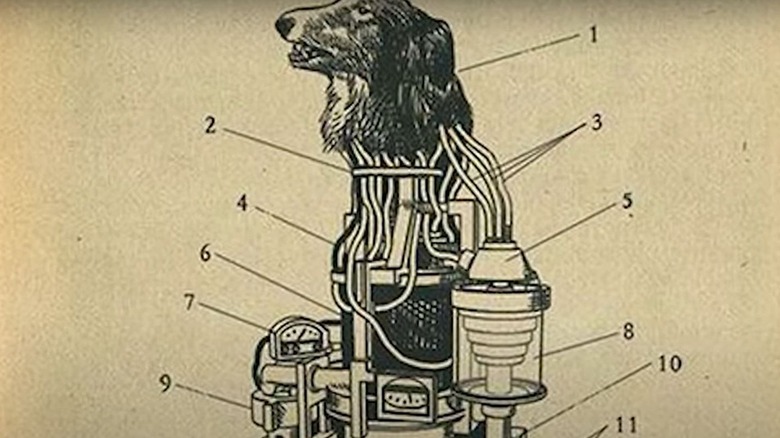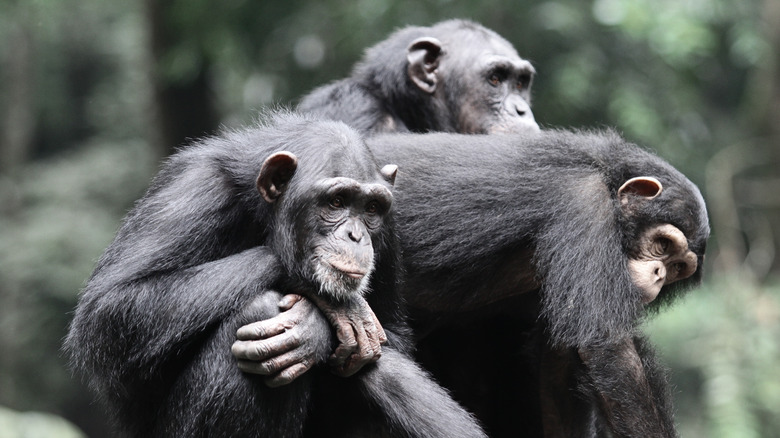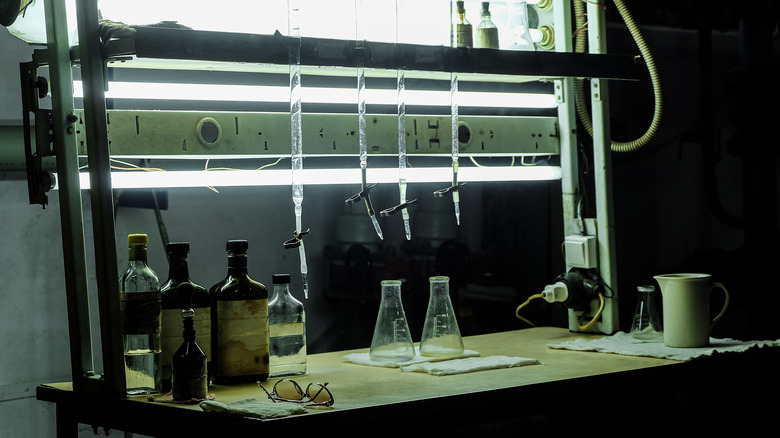Messed Up Experiments That The Soviet Union Conducted
During its 70-year existence (1921 to 1991), the Union of Soviet Socialist Republics (U.S.S.R.), or the "Soviet Union" for short, developed quite the global reputation for being a giant, evil empire. Birthed in the Lenin-led overthrow of czarist Russia during the Bolshevik Revolution of 1917, the Soviet Union quickly saw its "workers first" ideals wilt in the fist of dictator Joseph Stalin.
As History recounts, Stalin came into power in 1924 and stripped lower-class farmers of their goods. He funneled them up to those who could convert the nation from an agrarian to a military superpower, and as a result, nearly 3.9 million people died of starvation in Ukraine in an event called the "Holodomor." Then, from 1936 to 1938, Stalin executed about 600,000 political dissenters. This is all before the post-World War II Cold War between the U.S.S.R. and the U.S.A., which lasted from 1946 until the U.S.S.R. collapsed in 1991, as National Geographic recounts. Besides gifting us a slew of Hollywood-style villains, the Cold War left an unwashable mar on the West's vision of Russia, all the way down to single words like "socialism."
The Soviet Union pushed relentlessly to get ahead in military, technological, and scientific spheres. They developed their own atomic bomb in 1949, just four years after the United States, per History. They sent the first satellite, Sputnik I, into orbit in 1957 (via NASA), then the first human, Yuri Gagarin, in 1961 (per Britannica). Other scientific advances, though? They relied on experiments ranging from absurd to abjectly cruel.
Decapitated dogs Frankensteined to life
A quick warning from here on out: Soviet scientists got up to some seriously disturbing stuff. There's no shame in having to bail, or in having to resort to humorless chuckles of the darkest, most tragi-comical kind just to cope. This is especially true because lots of messed-up Soviet experiments involved animals, particularly dogs. We suppose that dogs, full of nothing but eternal adoration for their human besties, were the easiest prey to escort to their deaths.
First up: decapitated dog heads attached to machines full of valves, tubes, meters, electric wires, and such (actual diagram above). Yes, this sounds far less like government-funded "science," and more like the lovingly detailed daydream of a serial killer-in-training. What could possibly be the purpose of such so-called research? At the very least, as Courier Mail describes, it supposedly provided insights used during open-heart surgery. At most, it was a way to investigate how to bring the clinically dead back to life.
In the 1940 documentary "Experiments In The Revival Of Organisms," researchers Sergei Brukhonenko and Boris Levinskovsky showed off their Dr. Frankensteinian reanimation process. They removed dogs' hearts and lungs and connected them to an external machine dubbed an "autojektor," to keep them beating and pumping air, respectively. After 10 minutes, they rewired the machine back into the dogs' severed heads. This gave the dogs several sustained minutes of apparently conscious, body-less agony. Via Interesting Engineering, the dogs apparently blinked, wiggled their ears, and licked their mouths.
Cerberus, one head less
As Courier Mail explains, Soviet surgeon and professor Vladimir Demikhov took to severing the heads, necks, and sometimes legs, of puppies and grafting them into the still-living bodies of other, larger dogs. He then tied the dogs' circulatory systems together so that the larger dog's vessels fed the smaller dog, like some horrific parasitic twin.
Demikhov worked in East Germany during the Cold War, and using this procedure created some 20 or so "double-dog" creations. Most of these poor, agonized creatures died within days due to tissue rejection, as the host dog's body treated the smaller dog like an incompatible transplant. Immunosuppressants weren't used until the late 1950s, as the American Heart Association explains, so there was no way for Demikhov to stop the host dog's immune system from combating the smaller dog's tissue. Most dogs died within days, but one duo apparently lived for a month. While alive, both dogs could move independently (as much as they could). The smaller dog still ate and lapped up water, but because it had no stomach, the food and water just sloshed out of a tube directly onto the floor.
As is sometimes the case, sites like Interesting Engineering seek to retrospectively justify such experiments because of the insights they provided to human medicine, in this case to organ transplants. But the question begs: does a species that tortures life in such a way deserve prolonged existence?
Wholesale dog slaughter via nerve gas
And so we turn to the final dog-torturing Soviet experiment, but not the final animal-tormenting experiment. This time, there's no supposedly pro-social aim like heart surgery or organ transplants. The goal, brought to life during the 1970s and '80s, was to create a group of nerve agents dubbed "Novichok," Russian for "newcomer." As the BBC notes, the existence of Novichok wasn't even confirmed until the 1990s when Dr. Vil Mirzayanov defected to the U.S. and brought Novichok's chemical formula with him. Novichok, it turns out, were fourth-generation nerve agents developed within a specific program under the codename Foliant.
Novichok was tested on dogs stuffed into cages by the hundreds, if not thousands, and forced to walk on tiny treadmills with gas masks strapped to their faces. It's unknown how long these tests were conducted, but we know, as Courier Mail reports, that the experiments took place at the benignly-named Chemical Research Institute, abandoned in 1992 following the collapse of the Soviet Union. Simply put, the dogs were exposed to Novichok to test the nerve agent's effects, which in humans includes convulsions, coma, nausea and vomiting, profuse sweating, shortness of breath, and eventually death.
In 2018, Novichok was deployed in a terrorist attack in the UK that left 21 hospitalized, as News Corp Australia reported. The target was former Russian double-agent Sergei Skripal and his daughter, Yulia. Then-Prime Minister Teresa May accused Russia of the attack, but perhaps unsurprisingly, Vladimir Putin denied it.
Human plus chimpanzee equals humanzee
Lest you think things couldn't get more messed up, it's time to chuck another resident from the Island of Dr. Moreau onto our list of Soviet-era abominations to nature. The "humanzee" ticks a whole bunch of fundamentally reprehensible boxes: animal torture, human rights desecration, violation of the basic sanctity of life, interspecies impregnation — you name it.
We're sorry to say this entry is exactly what it sounds like. In the 1920s, Soviet biologist Dr. Ilya Ivanovich Ivanov artificially (we hope) inseminated a female chimpanzee with human sperm in order to make a "humanzee," as Courier News recounts. The goal? As News Corp Australia says, Ivanov was trying to make a "Soviet super-soldier." Why he thought he'd create the Red Guardian (Soviet Captain America) instead of a hairy and untrainable soldier is beyond us. Come 1929, Ivanov wanted to do the opposite: impregnate human females with chimp sperm. Thankfully, the latter experiment fell through despite his attempts to organize it. And the former? No humanzees were ever successfully born.
By all accounts, Ivanov wasn't alone in his ambitions. Via News Corp Australia, University of Albany professor Gordon Gallup claimed to have caught wind of humanzee experiments conducted at Orange Park, Florida, in the 1920s. There's no evidence to back up his claims, but Gallup stated that researchers actually succeeded, then got freaked out by the whole thing and killed the infant. Gallup himself has also entertained ideas of "hurillas" (human-gorilla hybrids) and "hurangs" (human-orangutan hybrids).
The poisons and murders of Doctor Death
You know if history has dubbed you "Doctor Death," you've taken a wrong turn somewhere in life. Such was the case with Grigory Mairanovsky, a Soviet biochemist who came to oversee the not-at-all-villainously-named "Laboratory No. 1" in 1939, per Courier Mail. Laboratory No. 1 was the U.S.S.R.'s first official "poison laboratory" opened in 1921 under the codename "Special Office." As Atlas Obscura says, the facility went by a variety of monikers over the years, including Lab X and Laboratory No. 12.
The purpose of Laboratory No. 1 was simple: to develop "tasteless, odorless chemicals that couldn't be detected after death," and thereby create the perfect assassination tool. For this, Doctor Death needed subjects. He turned to Soviet gulags to provide him and his cartoonishly sinister agenda with all the "enemies of the people" he needed. He administered to his subjects variations of mustard gas, ricin, digitoxin, curare, and cyanide, and sat back and watched them suffer and die. Eventually, Mairanovsky created something called "carbylamine choline chloride" (C-2 or K-2), had the added benefit of bestowing calmness on people along their way to death 15 minutes later.
A KGB defector spread the word about Laboratory No. 1 in 1956. Ironically, Mairanovsky himself was eventually hunted by Stalin as part of a political purge, although Laboratory No. 1 was reportedly reactivated in the late 1990s for the "creation of biological and toxin weapons for clandestine operations in the West." It's unknown how many people died there.
Deaths of millions from starvation
We've mostly described "messed up experiments" as things conducted by depraved and sociopathic scientists cackling over corpses and spliced-up animals in laboratories. However, Soviet biologist Trofim Lysenko, who crouched over plants in fields and advised farmers on how to grow their crops, might have, in the words of the Atlantic, "killed more human beings than any individual scientist in history." Guns, cannons, plagues, poisoned gulag detainees, swathes of gassed and dead dogs, even atomic weaponry itself: nothing took as many lives, indirectly, as Lysenko's food-based experiments.
Illiterate until the age of 13, Lysenko made his way into agriculture school following the Bolshevik Revolution of 1917, embellished some experimental results, got praise from a state-run newspaper in 1927, and was put in charge of all of Soviet agriculture by the 1930s. The Soviet people and government praised him for his undereducated, salt-of-the-earth authenticity, and dubbed him the "barefoot scientist." For his part, Lysenko didn't believe that genes existed, and called such scientific knowledge "reactionary and evil." He denied farmers the use of fertilizers and pesticides, and outlined a new way to plant seeds based on what he called the "law of the life of species," in which plants of various categories shouldn't, much like communist farmers themselves, compete with each other.
In the end, 30 million people died of starvation because of Lysenko's real-life experimental tinkering. Folks were "reduced to eating tree bark and bird droppings and the occasional family member."
Feeding on the blood of the young
You wouldn't think that state-sanctioned vampirism would be one of the less ghoulish items on this list. But strangely enough, it is, if only because its effects were limited to one person: project lead Alexander Bogdanov. Unlike "Doctor Death," Bogdanov wasn't a secret, sinister scientist. As Gizmodo explains, he was a fairly well-known researcher and, of all things, science fiction writer during the early days of the pre-Stalin Soviet Union in the early 1920s. He was around for the Bolshevik Revolution in 1917, and in his fiction wrote of utopias managed by automated machines that gave citizens greater liberties of labor and free time.
Unfortunately, Bogdanov also believed that the blood of the young would prevent him from aging. We're not talking Elizabeth Báthory de Ecsed's (1560-1614) levels of sadism — in case you need a refresher, she was a Hungarian noblewoman who tortured and slaughtered hundreds of female children aged 10 to 14 in order to drink their blood and literally bathe in it (via History Hit). Thankfully, unlike Báthory, Bogdanov only took willing participants. He transfused the blood of 11 individuals directly into himself in a vie for immortality, and as a result, actually wound up completing some of history's first successful blood transfusions, as OpenMind BBVA explains. In the 1930s, Soviet surgeon Serguei Yudin would carry the baton onward towards viable medical purposes.
Incompatible blood types being what they are, Bogdanov died from his experiments. Besides this, his test subjects all suffered from varying diseases, including tuberculosis.
Cellular life startup kit
This next entry appears mild, but is horrifying in its implications. Given all the aforementioned macabre and sadistic Soviet experiments conducted on animals and people, if the current research had ever gotten to a true experimental phase, it could have produced horrifying petri dish monstrosities straight out of a body horror film.
In 1924, Soviet biochemist Alexander Oparin pitched what we've come to know as the "primordial soup" theory. As Physics of the Universe summarizes, Oparin believed, "There is no fundamental difference between a living organism and lifeless matter," and outlined how the right combination of organic chemicals produced the first membraned cells in Earth's ancient oceans. Working backward from Darwin's theory of natural selection, Oparin sought to overturn one of biological life's most fundamental principles: life comes from life.
Oparin created artificial cells that could house enzymes, and more or less wanted to create a "starter kit" for life using unliving materials. He became a biochemistry teacher at Moscow State University in 1927, and as Britannica outlines, was a well-respected researcher, won numerous awards, and organized the world's first international "meeting of the origin of life" in Moscow in 1957. While he died without having taken his research to its next, most logical, organism-creating step, researcher Olga Lepeshinskaya took the baton and claimed that dead cells produced matter that could be harvested into a "vital substance" used for the creation of new life. As OpenMind BBVA explains, she was later proven a fraud.
Psychic tests using tortured kittens
Time to get back to the grotesque and absurd by combining two of the Soviet Union's favorite pastimes: animal torture and espionage. And this time, the espionage takes on a particular "X-Files" kind of flavor. As described in an original 1977 The New York Times article, Soviet expat August Stern worked in a "secret Siberian laboratory" investigating "psi particles," fictional, physical, measurable particles responsible for parapsychological abilities. We're not saying "psi particles" sound suspiciously like George Lucas' Force-explaining "midi-chlorians" from the "Star Wars" prequels, but still, maybe Lucas read this article back in the day.
As The New York Times summarizes, the Soviets investigated four discrete abilities: extrasensory perception (ESP), telepathy, telekinesis, and clairvoyance. Stern and his team of 60 researchers were recruited from around Russia and given "virtually unlimited funds" to plumb the truth of the paranormal. Around the same time, the CIA did the same thing, as the Guardian reports. Per Scientific American, such research in the U.S.S.R. extended back to the 1920s.
By itself, this just might sound wacky, not sinister. However, in order to test their theories, Soviet researchers took to cruel absurdities. They shocked newborn kittens to see if their mothers, three floors above, reacted. They implanted electrodes in a mother rabbit's brain, took her babies to a submarine and killed them one by one to see if she psychically felt it. They tested photonic waves using frog eyes, placed monkeys inside powerful magnetic fields, and more.
Abandonment of 'defective' children
Our last entry isn't a single, standalone experiment, but rather a pervasive, nationwide experiment with teaching methods for children. The newly established Soviet state wanted to groom its youth according to principles of "work, collectivity, and modernity," as Professor of History Loraine de la Fe at Florida International University states. "Comrade child's discipline" depended on propaganda by way of new "literature, fiction, nonfiction, children's journals, and school curricula and activities."
As the journal History of Education describes, the U.S.S.R. deployed their burgeoning "child science" to turn entire generations into experimental fodder. During the 1920s and '30s, homogenization was a key goal. Those with "faults of character" that left them "low-achieving," "troublesome," or "nervous" were placed side-by-side those with physical "defects" such as blindness. Those with actual psychological disorders and varying levels of mental disabilities were clumped in with them, as well. By 1936 an entire sub-discipline of "defectology" cropped up within the U.S.S.R., where those children who were "imperfect" were separated from those who weren't, and shipped off to sanitoriums. Orphans were included in this list, too.
The Atlantic describes the fallout from such practices, citing Romania as its example. Romania was occupied by the U.S.S.R. from 1945 to 1989, as Britannica explains, and modeled itself on the Soviets, down to its Communist dictator, Nicolae Ceausescu. Come 1990, under Ceausescu,170,000 abandoned infants, children, and teens were found inside a network of "child gulags" resulting from the overall Soviet policy of "defectology."










